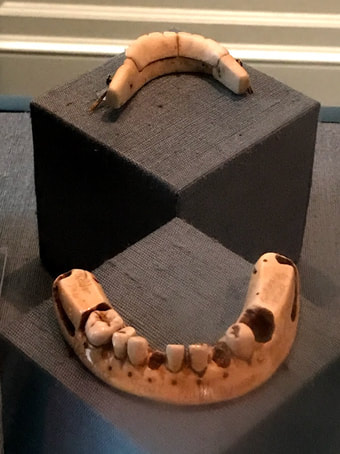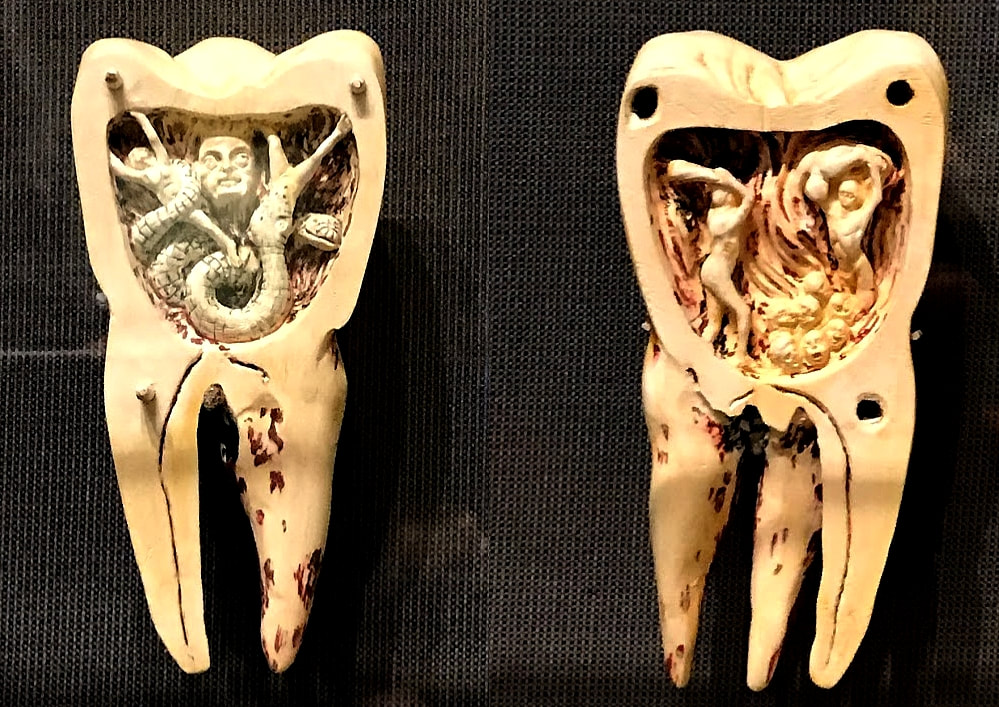 George Washington's Dentures George Washington's Dentures I recently visited the National Museum of Dentistry in Baltimore. One of their valued exhibits is the dentures of the first president of the United States, George Washington. These dentures were made out of ivory (not wood as in the popular myth) and were quite cumbersome to wear. These dentures also reflected a sad reality. In Washington’s time, most people who lived to old age had lost a significant number of their teeth. This tooth loss process, all the accompanying misery and pain associated with it, and the risks of infection and death associated with tooth extraction in those days before antibiotics an anesthesia, was made much worse by the introduction of refined sugar into Europe and North America. But I’m getting ahead of myself. What did the best minds of antiquity consider to be responsible for tooth decay? The two objects below are also at the National Museum of Dentistry. The objects are a replica of a French sculpture from the 1700s. They depict two halves of a tooth. The left half fits into the right half to reproduce the full tooth. Inside the right half there is a ghastly rendition of the fires of hell with human beings being cast into the flames. This makes a reference to the sufferings experienced by people with toothaches. The left half depicts a scene where a man is devoured by a tooth worm.  The Tooth Worm The Tooth Worm Now, what exactly is a "tooth worm"? The tooth worm was an explanation for why people experienced toothaches! It was believed that this worm appeared inside the tooth or made its way into the tooth and then caused the pain. References to the tooth worm go back thousands of years, and treatments for dental pain included strategies ranging from the chemical to the magical to coax the tooth worm out or make it go dormant. Many claimed to have found tooth worms during the process of tooth extraction, but such occurrences either had to do with regular worms that lived as parasites in the gums of individuals, or with normal structures such as tooth nerves that were mistaken for worms. The tooth worm explanation, although widespread, never led to any effective treatments or strategies for preventing toothaches or tooth decay. As science came of age, the thinking and procedures of the scientific method began to be applied to figuring out what was going on with people’s teeth. Below I present an abbreviated timeline taken from a great article by Ruby and coworkers published in the International Journal of Dentistry in 2010.
In the year 1700 the Dutch scientist, Antonie van Leeuwenhoek (who invented the microscope), was sent some alleged tooth worms for analysis. He found that these worms were no different from those found in cheese, and he also isolated these worms from the mouth of people who ate said cheese. Leeuwenhoek also took samples from decayed teeth and observed they had tiny living things that he called “animalcules” (little animals), and which we now know to be bacteria. Pierre Fauchard (considered the father of mother dentistry), carried out extensive studies of diseased teeth in 1728, finding no worms, and suggested that sugar consumption enhanced tooth decay. It became clear to many scientists that there was no such thing as a tooth worm. But then, what caused tooth decay? A series of hypotheses (some nearly as fanciful as the tooth worm) were proposed from “temperature changes”, “imbalances”, and “internal factors”, to “heredity”. Several scientists in the first half of the 19th century observed that tooth decay started from the outside and proposed that it was caused by external chemical agents. Later in 1876, Pasteur demonstrated that fermentation of sugars was a chemical process caused by microorganisms. With the realization that many bacteria ferment sugars to acids, scientist like Greene Vardiman Black and Willoughby D. Miller in the late 19th century assembled the final theory that posited that bacteria ferment sugars and produce acid which erodes the dental surface producing cavities. Further work confirmed this theory and expanded it to refer to specific dental sites (plaque) and adapted it to the concept that tooth decay is an infectious and transmissible disease involving specific strains of bacteria. The understanding of the true nature of tooth decay, along with other advances, allowed the development of both preventive and restorative practices that revolutionized dental care worldwide. Today in countries like the United States, any person who follows the recommended guidelines of oral hygiene and has regular checkups performed by a dentist will experience but a tiny fraction of the dental problems suffered by our ancestors a few hundred years ago. This is the way science works. Magical thinking, superstitions, or erroneous ideas like the concept of a tooth worm that do not contribute to solving our problems fall by the wayside, and are replaced by ever more refined and focused views based on grasping aspects of reality though observation and experiment. The photographs are by the author and may be used with permission.
2 Comments
Tom Murphy
4/12/2019 10:26:53 am
I inherited a terrible and unavoidable proclivity for gyngivitis and subsequent tooth loss. My grandmother lost all her teeth by age 30, and two aunts, one uncle and myself were similarly afflicted. As if that weren’t enough, we all developed autoimmune resorption by about age 70. Teeth hollowed out and broke to pieces. The only remedy has been root canals and crowns, implants and about 4 partials. Got too old...
Reply
Rolando Garcia
4/18/2019 05:18:54 pm
Sorry about your problem. This disease clearly has a genetic component, and scientists are actively searching for the genetic basis of diseases. That will be the great challenge of the future. Hopefully, we will be able through genetic therapy or other means to eradicate or at least ameliorate the effects of many of these diseases. Thanks for your comment.
Reply
Your comment will be posted after it is approved.
Leave a Reply. |
Details
Categories
All
Archives
June 2024
|
 RSS Feed
RSS Feed